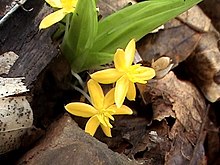Curculigo
| Curculigo | |
|---|---|

| |
| Curculigo orchioides | |
| Scientific classification | |
| Kingdom: | Plantae |
| Clade: | Tracheophytes |
| Clade: | Angiosperms |
| Clade: | Monocots |
| Order: | Asparagales |
| Family: | Hypoxidaceae |
| Genus: | Curculigo Gaertn. |
| Synonyms[1] | |
| |
Curculigo is a flowering plant genus in the family Hypoxidaceae, first described in 1788. It is widespread across tropical regions of Asia, Africa, Australia, and the Americas.[1][2]
Curculin is a sweet protein that was discovered and isolated in 1990 from the fruit of Curculigo latifolia,[3] a plant from Malaysia. Like miraculin, curculin exhibits taste-modifying activity; however, unlike miraculin, it also exhibits a sweet taste by itself. After consumption of curculin, water and sour solutions taste sweet. The plant is referred to locally as 'lembah' or 'lumbah'; English: 'weevil-wort'.[4]
- Species[1]
- Gagnep. – Vietnam
- S.C.Chen – China (Guangxi, Guangdong)
- Gagnep. – Vietnam
- Gagnep. – Vietnam
- Curculigo ensifolia R.Br. – Australia
- Lauterb. – Philippines, Sumatra, New Guinea, Solomon Island
- M.R.Almeida & S.Yadav – Maharashtra
- Curculigo orchioides Gaertn. – China, Japan, Indian Subcontinent, Papuasia, Micronesia
- R.D. Gore & S.P. Gaikwad – India
- S.P. Gaikwad & Gore – India
- (Schumach. & Thonn.) Engl. – tropical Africa, Madagascar
- Ridl. – Borneo
- M.R.Almeida & S.Yadav – Maharashtra
- (Lam.) Baker – southern Mexico, Central America, West Indies, northern South America
- Bojer ex Baker – Seychelles
- S.C.Chen – China (Yunnan)
- Gagnep. – Vietnam
References[]
- ^ a b c Kew World Checklist of Selected Plant Families
- ^ Flora of China Vol. 24 Page 271 仙茅属 xian mao shu Curculigo Gaertner, Fruct. Sem. Pl. 1: 63. 1788.
- ^ Yamashita H, Theerasilp S, Aiuchi T, Nakaya K, Nakamura Y, Kurihara Y (September 1990). "Purification and complete amino acid sequence of a new type of sweet protein taste-modifying activity, curculin". J. Biol. Chem. 265 (26): 15770–5. PMID 2394746.
- ^ Hean Chooi Ong (2004). Tumbuhan liar: khasiat ubatan & kegunaan lain. Utusan Publications. p. 24. ISBN 9676116300.
- Curculigo janarthanamii Gore & S.P.Gaikwad, Phytotaxa 357(1): 72 (2018).
- Curculigo sabui S.P.Gaikwad & Gore, Nordic J. Bot. 37(7)-e02340: 2 (2019)
External links[]
Categories:
- Curculigo
- Asparagales genera
- Asparagales stubs